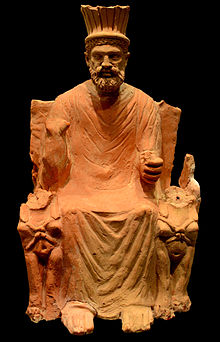Baal Hammon,properlyBaʿal Ḥamon(PhoenicianandPunic:𐤁𐤏𐤋 𐤇𐤌𐤍,romanized:Baʿl Ḥamōn),[1]meaning "Lord Hammon", was the chief god ofancient Carthage.He was aweather godconsidered responsible for thefertility of vegetationand esteemed asking of the gods.He was depicted as a bearded older man with curling ram's horns.[2]Baʿal Ḥammon's female cult partner wasTanit.[3]
| Baʿal Ḥammon | |
|---|---|
 Statue of Baʿal Hammon on his throne with a crown and flanked bysphinges,1st century. | |
| Consort | Tanit |
| Equivalents | |
| Canaanite | El |
| Greek | Cronus |
| Roman | Saturn |
Etymology
editHe is identified as one of the Phoenician deities covered under the name ofBaal.[4]However, the meaning of his second name is unclear. Frank Moore Cross argued for a connection toHamōn,theUgariticname for Mount Amanus, a peak in theNur Mountainsthat separateSyriafromCilicia.[5]In the 19th century, whenErnest Renanexcavated the ruins of Ḥammon, nowUmm al-Amad,betweenTyreandAcre,he found two Phoenician inscriptions dedicated toEl-Ḥammon.[6]
Others have proposed Ḥammon as asyncreticassociation withAmun,the god ofancient Libya,[7]InSiwa Oasis,a solitaryoracleof Amun remained near theLibyan Desert,[8]while a last current has called instead for a connection with theNorthwest Semiticwordḥammān"brazier",suggesting the sense" Lord of the Brazier ".[6]
Cult and attributes
editThe worship of Baʿal Hammon flourished in thePhoeniciancolony of Carthage. His supremacy among the Carthaginian gods is believed to date to the fifth century BC after relations between Carthage andTyrewere broken off at the time of theBattle of Himera (480 BC).[9]Baal Hammon was known as the Chief of the pantheon of Carthage and the deity that made vegetation grow; as with most deities of Carthage, he was seemingly propitiated withchild sacrifice,likely in times of strife or crisis, or only by elites, perhaps for the good of the whole community. This practice was recorded by Greeks and Romans, but dismissed as propaganda by modern scholars, until archeologists unearthed urns containing the cremated remains of infants in places of ritual sacrifice. Some scholars believe this confirms the accounts of child sacrifice, while others insist these are the remains of children who died young.[10][dubious–discuss]
He has been identified with a solar deity,[6]althoughYigael Yadinthought him to be a moon god.[11]Edward Lipińskiidentifies him with the godDagon.[12]In Carthage and North Africa, Baʿal Hammon was especially associated with the ram and was also worshiped as thehorned deityBaʿal Qarnaim "Lord of the Two Horns" in an open-air sanctuary atJebel Boukornine( "the two-horned hill" ) across the bay from Carthage, inTunisia.[13]
Theinterpretatio graecaidentified him with the TitanCronus.Inancient Rome,he was identified withSaturn,and the cultural exchange between Rome and Carthage as a result of theSecond Punic Warmay have influenced the development of the festival ofSaturnalia.[14][clarification needed].Attributes of his Romanized form as an African Saturn indicate that Hammon (AmunusinPhilo's work) was a fertility god.[15]
Legacy
editThere is a survival in modern times inonomasticswith somefirst namesin use particularly inTunisiagrafted onto the name of the god. Algerian, Tunisian and many other spoken forms of Arabic refer to "Baalifarming "to refer to non-irrigated agriculture.[16]Such usage is attested inHebrew,aCanaanite languagesister toPhoenician,already in the 2nd century CEMishnah.[17]
A street inmodern Carthage,located near the Punic Ports, bears the name ofBaal Hammon.[18]
The city ofCarmona(Andalusia,Spain) is believed to derive its name fromKar-Hammon,"city of Hammon."[19]
See also
edit- Baal-zephon,the storm god ofJebel Aqra
- Beelzebub
- Punic religion
References
edit- ^Krahmalkov, Charles R. (2000).Phoenician-Punic Dictionary.Leuven: Peeters. p. 113.ISBN90-429-0770-3.
- ^Baratte, François;Louvre(1994).From Hannibal to Saint Augustine: Ancient Art of North Africa from the Musée Du Louvre.Michael C. Carlos Museum, Emory University.ISBN978-0-9638169-1-7.
- ^Serge Lancel.Carthage: A History.p. 195.
- ^"Carthaginian Religion".World History Encyclopedia.Retrieved2017-08-04.
- ^Cross, Frank Moore (1973).Canaanite Myth and Hebrew Epic.Harvard University Press. p. 26-28.ISBN9780674091764.Retrieved19 January2017.
- ^abcWalbank, Frank William (1979).A Historical Commentary on Polybius,Volume 2, Clarendon Press, p. 47
- ^S. G. F. Brandon,Dictionary of Comparative Religion,1970, Littlehampton, 978-0297000440
- ^Pausanias,Description of Greecex.13 § 3
- ^Moscati, Sabatino (2001).The Phoenicians.Tauris, p. 132.ISBN1-85043-533-2
- ^Kennedy, Maev (21 January 2014)."Carthaginians sacrificed own children, archaeologists say".The Guardian.Retrieved19 May2020.
- ^ידין, יגאל(1967)."על סמלי האלים בשמאל (זינג'ירלי), בקארתאגו ובחצור (Symbols of Deities at Zinjirli, Carthage and Hazor)".ידיעות בחקירת ארץ-ישראל ועתיקותיה (Yediot Bahaqirat Eretz-Israel Weatiqoteha)(in Hebrew).31(1/4): 29–63.ISSN2312-0061.JSTOR23734250.
- ^Edward Lipiński,Dictionnaire de la civilisation phenicienne et punique(1992:ISBN2-503-50033-1).
- ^Roberto Peter Bongiovanni (2014)."The Interchange of Plain Velar and Aspirate in Kronos/Chronos: A Case for Etymological Equivalence".Master's thesis at City University of New York.
- ^Robert E.A. Palmer,Rome and Carthage at Peace(Franz Steiner, 1997), pp. 63–64.
- ^Serge Lancel (1995).Carthage: A History,p197.
- ^Ottavo contributo alla storia degli studi classici e del mondo antico Arnaldo Momigliano - 1987 p240.
- ^"Mishnah Sheviit 2:9".www.sefaria.org.Retrieved2021-08-10.
- ^/place/Rue+Baal+Hammon,+Tunisie/@36.8480006,10.3239041,753m/data=!3m2!1e3!4b1!4m5!3m4!1s0x12e2b4cac8227357:0x5d79c4f871806c6!8m2!3d36.8479963.26d19028, Rue Baal Hammon Archaeological Site of Carthage, Tunisia,atgoogle.com/maps
- ^Garvey, G., Ellingham, M. (2003:326).The Rough Guide to Andalucia.United Kingdom:Rough Guides.
External links
edit- On-line parallel Bible:Song of Solomon8:11